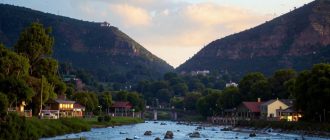
President of Pro-Vision, author of Vinogradov.story community
“Nature has awarded Abkhazia with a huge number of inspiring objects, and the rich history of the republic has added to them amazing temple complexes, recreational areas and nomenclature architecture. The result is a unique mix that everyone who finds themselves on the Black Sea coast should dive into.”
Russians do not need visas or passports to travel to Abkhazia – a regular passport will suffice. Those who are planning a road trip (and it will allow you to see maximum sights at a time) better to refuse personal transport with Russian license plates and rent a car after crossing the border. Or immediately rent a car with a local driver: in this case, the beauty of Abkhazia will almost certainly be complemented by an excellent story with genuine interest in the native country.
Lake Ritsa
The high-mountainous Ritsa is one of the pearls of Abkhazia, which in no way can be ignored on a trip to the country. Located in the national park, it is surrounded by the same legendary locations. So, climbing up the mountains, travelers first get to the Blue Lake, almost immovable surrounded by high cliffs. Then – to the waterfalls of Maiden’s and Man’s Tears, where they usually make a wish. And, finally, they meet Ritsa itself, to which steep mountain slopes descend. An obligatory part of the trip is a glider ride around the lake. Not obligatory, but very desirable – lunch or dinner with shashlik, local drinks and a beautiful view of Ritsa.
Those who are looking for a more chamber-like atmosphere can go up higher, to Malaya Ritsa Lake, walking about 5 km through an overgrown fir forest. The “younger sister” is noticeably inferior to the “older” in size, but it guarantees silence, purity and immersion in pristine nature.
Sukhum
The Abkhazian capital is attractive first of all because it gives an opportunity to immerse in the history of these places. The city has the largest museum in the republic, where both ancient artifacts, raised from the bottom of the Sukhumi Bay, and more modern objects of everyday life and art, illustrating the complicated history of the country, are exhibited. Sukhum is also the best place for gastronomic acquaintance with Abkhazian cuisine. Prices here are lower than in resorts, and the choice of dishes and establishments is quite comparable.
White rocks and Khashupse
Literally half an hour’s drive from the coast, waters of the Khashupse River washed a narrow deep canyon in steep limestone rocks. Hashupsin Canyon is a place of fantastic beauty: in sunny weather, the water in the canyon takes on a gentle blue hue, tinged with white rock and emerald southern forest. And when the rain raises heavy limestone suspended on the surface, the water becomes ivory-colored.
It is possible to descend to Hashupse only on ATVs – and this is a separate part of the trip, a little dangerous and very dynamic. The best way to walk through the canyon itself is on sapas, taking in the mind-blowing views. You can continue sap-walking near the White Rocks in Tsandripsh village. In the season this place will help you to get secluded away from vacationers, and in the off-season, if you are lucky, will please you with calm sea and natural contrasts of snow-white rocks, calm blue water and storm clouds.
State dachas
In the Soviet years, Abkhazia became a center of attraction for vacationers from all over the Union. Its recreational potential was appreciated not only by ordinary workers, but also by the party top brass, who built up the most attractive corners of the country with state dachas. Only Stalin’s residences number no less than five: in Novy Afon, on the Kholodnaya River, in Mussera and Sukhumi Arboretum.
The most famous dacha of Stalin is located on the northern shore of Lake Ritsa and is characterized by asceticism, which you would not expect to find in a residence of this level. General Secretary did not like luxury, but he favored high-quality natural materials – mainly valuable woods. The main advantage of the dacha is the surrounding nature and clean mountain air, the quality of which was measured daily by Stalin’s personal physician. The General Secretary visited this dacha only five times, but, unlike his other residences, did not receive visitors here, but only rested. Subsequently, next door service dacha built and Khrushchev. And Brezhnev would unite both objects by a passing gallery.
New Athos
New Athos is the center of cultural and spiritual life of the republic. Located here, the New Athos Simono-Kananite Monastery keeps a part of the Tree of the Life-Giving Cross, one of the largest among the currently preserved. The monastery was built in record time – only 12 years, and Emperor Alexander III took part in its creation. The territory of the monastery is beautiful and ennobled, and the walls of the monastery offer a magnificent panorama of the Black Sea. The architecture of the New Athos Monastery combined with the surrounding scenery creates a picture that remains in the memory long after returning from Abkhazia.
However, the monastery is not the only attraction of New Athos; no less famous is the unique Novoafon cave in the dungeons of Iver Mountain, which is several million years old. “Cave City” occupies 11 halls connected by a railroad track. On the route you can meet giant stone ramparts, cave lakes and stalactite palaces.
Gagra
Gagra is a graceful colonnade in the Moorish style, which is impossible to pass by without taking a couple of “obligatory” photos. Gagra is a legendary restaurant “Gagripsh”, which has preserved the interiors of the early XX century and the atmosphere of a social reception in pre-revolutionary Russia. Gagra is, finally, the luxurious Seaside Park, laid out by order of Prince Oldenburgsky. To contemporaries the park seemed an absolute miracle: well, where else in the Caucasus could one see date palms from the Canary Islands, Syrian mallows and Himalayan cedars? And even those who come to the park today, it is unlikely to leave indifferent: it seems too atypical and somehow “foreign” against the background of Abkhazian reality.
Pitsunda
Half of Pitsunda’s success is the sea: perhaps the cleanest and most transparent on the coast. The other half – pine trees: healing properties of Pitsunda pine are known far beyond the borders of Abkhazia, and the aroma risks knocking down a visiting metropolitan. If the purpose of the trip is beach vacation, there is no alternative to Pitsunda. The town has all the opportunities for it, and the network of local sanatoriums is considered one of the best in Abkhazia. Pitsunda is such a natural aerarium, from which you do not expect strong emotions and amazing discoveries. Only comfortable rest – and nothing superfluous.






